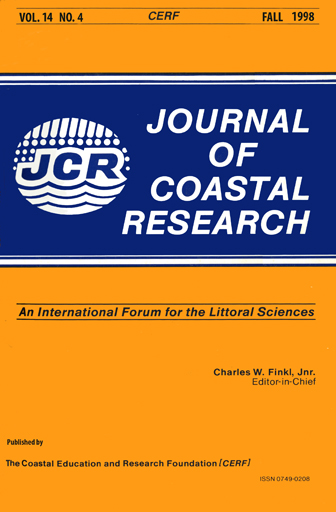Historical Development of a Foredune Plain at Desperate Bay, Western Australia
Keywords:
Coastal accretion, tombolo, shoreline movement, beach ridgesAbstract
Coastal accretion in Desperate Bay at Coolimba on the Central West Coast of Western Australia has resulted in formation of a small foredune plain. Since the area was first surveyed by aerial photography in 1944 the plain, which is approximately 150 metres wide and 1 km long, has partially filled a sheltered embayment and has linked with an islet to form a small tombolo. Deposition was particularly rapid between 1965 and 1990 with approximately 97,000 m3 accumulating on the coast during that time. Such levels of accretion are unusual in Western Australia and apparently elsewhere. Development of the plain has been investigated photogrammetrically through a geographic information systems (GIS) analysis of maps of shoreline movement and sequential aerial photography, field surveys of marine processes and coastal stratigraphy, and laboratory analyses of sediment characteristics and distribution. Historical records of shoreline movement show that the plain developed rapidly, with much of its formation taking place since 1965. Stratigraphic surveys are consistent with interpretation of the historical records that the plain has developed within recent historical time. Sediments within the landward part of the stratigraphic sequence include nylon rope similar to that currently used by the local rock lobster fishery. They also indicate that deposition of sediment occurred gradually, albeit with some variation in quantity induced by storm activity and deposition of wrack on the beachface. The process measurements indicate that mechanisms for deposition are related to increased southerly wind activity, coincidental with a decline in the frequency of northwesterly storm events during the past 30 years, and formation of a tombolo in the northern part of Desperate Bay. Foredune formation in Desperate Bay has occurred in an environment where there are very low levels of wave and tidal activity, compared to sea level ranging associated with frequent storm events. The foredunes have formed in response to intermittent washover of the backshore area of the beach during winter storms, when water levels and wave heights are raised. The storm deposition contributes sediment to the upper surface and lee side of the active foredune ridge to heighten and broaden it while producing a slow migration inland. Subsequent calm-weather accretion contributes a small aeolian cap to the foredune, gradually widens the beach, and eventually strands the ridge. In this respect, the foredunes of this very low energy coast primarily are considered to be a function of local surge height, and secondarily a result of sediment trapping by pioneer vegetation. However, more direct measurements of sediment transport processes and their interaction are required to test this proposition.


